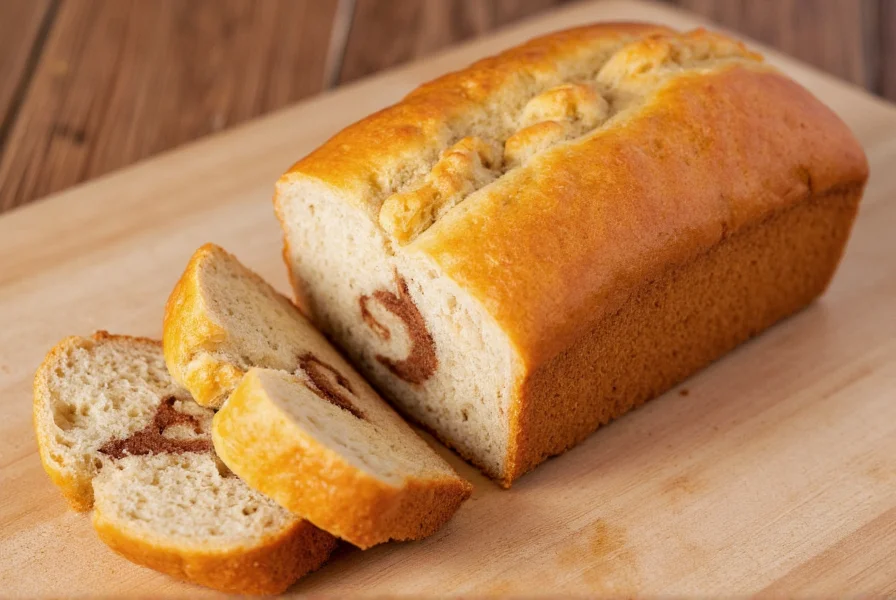There's something magical about the aroma of cinnamon bread baking in the kitchen. Unlike basic quick breads, this yeast-raised version delivers an exceptional texture—tender crumb with just the right amount of chew, wrapped in a beautifully caramelized crust. What sets this recipe apart is the double cinnamon technique: cinnamon in both the dough and the filling, creating layers of flavor that standard recipes miss.
Essential Ingredients for Perfect Cinnamon Bread
The quality of your ingredients directly impacts the final result. For authentic flavor, use real butter (not margarine) and freshly ground cinnamon—pre-ground works, but grinding whole cinnamon sticks releases more volatile oils for superior aroma.
| Ingredient | Amount | Professional Tip |
|---|---|---|
| All-purpose flour | 3 1/2 cups (440g) | Measure by spoon-and-level method for accuracy |
| Active dry yeast | 2 1/4 teaspoons | Test freshness by blooming in warm water first |
| Whole milk | 1 cup (240ml) | Warm to 110°F (43°C)—too hot kills yeast |
| Unsalted butter | 1/2 cup (113g) | Room temperature for proper dough incorporation |
| Cinnamon | 3 tablespoons | Use Ceylon cinnamon for complex flavor notes |
Step-by-Step Baking Instructions

Dough Preparation (45 minutes)
- Combine warm milk, 2 tablespoons sugar, and yeast in a small bowl. Let sit 5-7 minutes until foamy.
- Mix flour, remaining sugar, salt, and 1 tablespoon cinnamon in stand mixer bowl.
- Add yeast mixture and softened butter to dry ingredients. Knead with dough hook for 8 minutes until smooth and elastic.
- Place dough in greased bowl, cover, and let rise in warm spot for 1 hour or until doubled.
Swirl Assembly (20 minutes)
Proper swirl technique makes the difference between a marbled loaf and distinct cinnamon layers:
- Punch down risen dough and roll into 16x12 inch rectangle on floured surface.
- Spread softened butter evenly over dough, leaving 1/2-inch border.
- Mix brown sugar and remaining cinnamon, then sprinkle evenly over buttered dough.
- Starting from long side, roll dough tightly into log. Pinch seam to seal.
- Place seam-side down in greased 9x5-inch loaf pan. Cover and let rise 30 minutes.
Professional Baking Techniques
Most home bakers make these critical mistakes with cinnamon bread:
- Under-proofing: The second rise is crucial for proper texture. Dough should rise 1 inch above pan rim.
- Incorrect oven temperature: Use an oven thermometer—most home ovens run inaccurate.
- Cutting too soon: Wait minimum 45 minutes before slicing to prevent gumminess.

Baking Process
- Preheat oven to 350°F (175°C) with rack in center position.
- Bake 45-55 minutes until internal temperature reaches 190°F (88°C).
- Immediately brush top with melted butter and sprinkle with coarse sugar.
- Cool in pan 15 minutes, then transfer to wire rack to cool completely.
Variations and Troubleshooting
Adapt this easy cinnamon bread recipe to your dietary needs without sacrificing flavor:
Gluten-Free Adaptation
Substitute with 1:1 gluten-free flour blend. Add 1 teaspoon xanthan gum if not included in blend. Increase liquid by 2 tablespoons as GF flours absorb more moisture.
Vegan Version
Replace dairy with full-fat coconut milk and use vegan butter. For egg substitute, mix 1 tablespoon ground flaxseed with 3 tablespoons water.
Common Issues Solved
- Sunken middle: Underbaked or opened oven door too early. Use thermometer to verify doneness.
- Dry texture: Overmeasured flour or overbaked. Spoon flour into measuring cup rather than scooping.
- Faint cinnamon flavor: Use fresher cinnamon and consider adding 1/4 teaspoon cardamom for complexity.
Storage and Serving Recommendations
For optimal freshness, store cooled bread in airtight container at room temperature for up to 3 days. For longer storage, wrap tightly in plastic and freeze for up to 3 months. Thaw at room temperature before serving.
The best homemade cinnamon bread deserves proper presentation. Slice with serrated knife using gentle sawing motion. Serve slightly warmed with softened butter or cream cheese spread. Pairs beautifully with strong coffee or vanilla chai tea.
Frequently Asked Questions
Can I make this cinnamon bread recipe without a stand mixer?
Yes, you can make this recipe by hand. Mix ingredients in large bowl, then knead on floured surface for 10-12 minutes until smooth and elastic. The dough should pass the windowpane test—stretch a small piece thin enough to see light through without tearing.
Why does my cinnamon bread collapse after baking?
Collapse usually occurs from underbaking or opening the oven door during the first 30 minutes of baking. Verify doneness with thermometer (190°F internal temperature). Also ensure proper yeast activation—water temperature between 105-115°F is critical for optimal rise without killing yeast.
How can I enhance the cinnamon flavor in my bread?
For more pronounced cinnamon flavor, toast whole cinnamon sticks in dry skillet until fragrant, then grind fresh. Add 1/4 teaspoon cinnamon oil to the dough. You can also create a cinnamon syrup (1/4 cup sugar + 2 tsp cinnamon + 2 tbsp water) and brush on warm loaf for intense flavor infusion.
Can I prepare cinnamon bread dough ahead of time?
Yes, refrigerate the shaped loaf in its pan (covered) for up to 18 hours. On baking day, remove from refrigerator 1 hour before baking to complete the rise. Alternatively, freeze fully baked and cooled loaf for up to 3 months—thaw at room temperature before serving.











 浙公网安备
33010002000092号
浙公网安备
33010002000092号 浙B2-20120091-4
浙B2-20120091-4